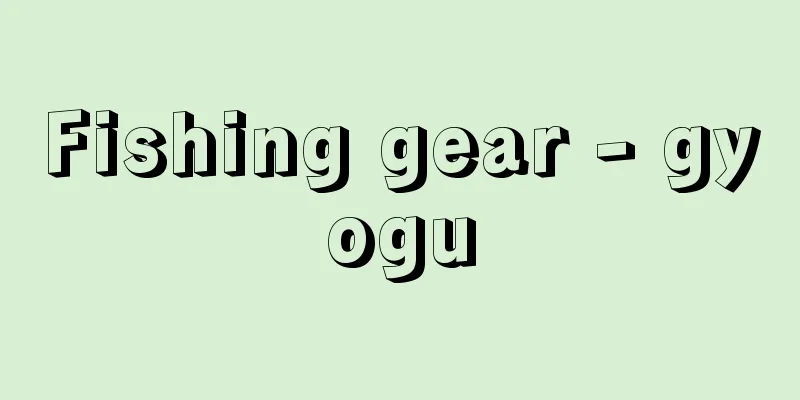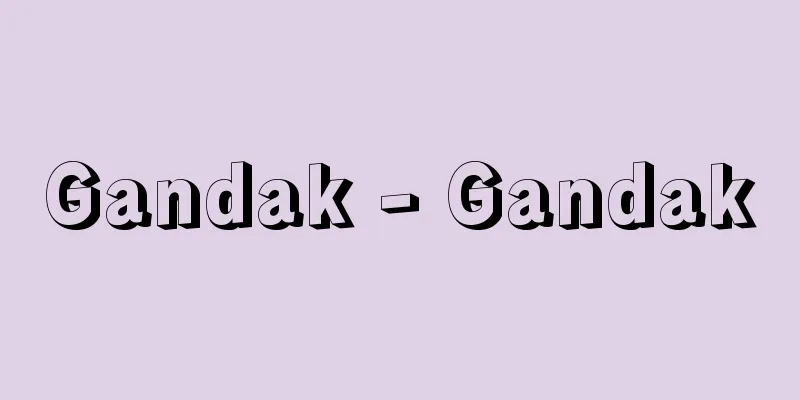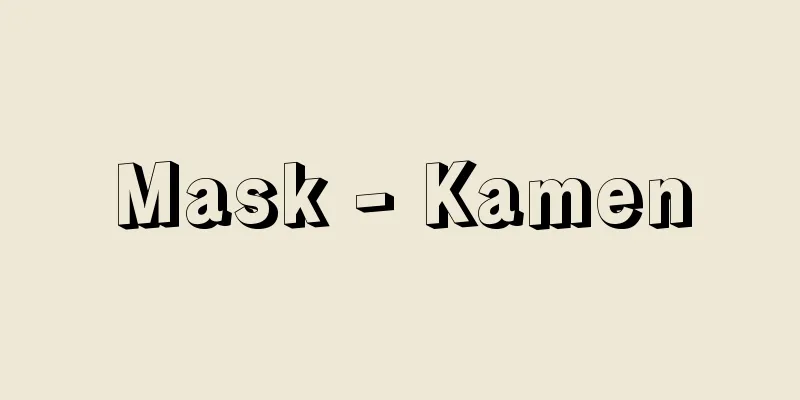Fishing gear - gyogu

|
A general term for equipment such as nets and fishing tackle used to capture aquatic plants and animals such as fish, shellfish, and seaweed. In a broad sense, fishing gear is divided into main fishing gear, auxiliary fishing gear, and sub-gear, which are organized and function on a fishing boat basis, but generally, only the main fishing gear is simply called fishing gear. Main fishing gear is equipment that is used directly in fishing and plays a major role, and is divided into three types: net fishing gear, lining fishing gear, and miscellaneous fishing gear, which includes all other fishing gear. Auxiliary fishing gear is equipment used in conjunction with the main fishing gear, such as fish-attracting lights, fish finders, and fishing gear monitoring devices, to effectively and reliably fish, while sub-gear is a general term for equipment such as various winches, hauling nets, and hauling lines, which are used to speed up and simplify the operation of the main fishing gear and increase operational efficiency, and is now called fishing machinery. [Yasuo Sasagawa and Teisuke Miura] Fishing gear classificationThere are many types of fishing gear, and there are various ways to classify them, but the most common classification is one that focuses on the fishing method and also takes into account the structure. The above-mentioned net fishing gear, jigs, and miscellaneous fishing gear are further divided into operational fishing gear (active fishing gear) and fixed fishing gear (passive fishing gear) based on the functional differences in the fishing gear's effect on the captured organisms. Since operational fishing gear is actively operated to catch organisms, the fishing ability of this type of net fishing gear is determined not only by its underwater shape and size, but also by the operation of the gear in response to the motor functions of the organisms to be caught. In contrast, fixed fishing gear uses trick fishing methods that take advantage of the senses and habits of organisms, waiting for them to move or be caught, so even subtle changes in fishing gear conditions that may seem subtle to the human sense can significantly change the fishing performance. Each fishing gear classified in this way can be further classified, but here we will provide an overview of the main fishing gear. [Yasuo Sasagawa and Teisuke Miura] Fishing nets[1] Operating net fishing gear (1) Seine nets: Fishing gear in which a long dragline is attached to a bag-shaped net and pulled horizontally through the water to catch target fish. They are classified into beach seine nets and boat seine nets. Beach seine nets are fishing gear that uses the shore as a base and pulls the net to the shore. Boat seine nets are fishing gear that pulls the net onto a boat. There are two types: seine nets, which are anchored in a fixed location and the net is pulled to the boat, and towing nets, which are pulled around by a moving boat. Most seine nets are designed to catch bottom-dwelling organisms, and only the pelagic seine nets, a type of seine net, are designed to catch surface fish. Bottom seine nets target bottom-dwelling organisms and are pulled while still attached to the bottom. There are two types of this net: the one-bag double-wing type, which has two wings on either side of the opening of the bag net and is pulled by two towing ropes, and the one-bag type, which lacks the wings and has a girder frame or beam attached in front of the opening of the bag net and is operated by a single towing rope. The one-bag double-wing type includes various hand-pulled nets, while the one-bag type includes various girder nets. Pulled nets are pulled around by moving a boat while keeping the net on the bottom. The boat can move horizontally using the wind and tides, or vertically using power. The former type includes various types of cast-off nets, and the latter includes many important types in the fishing industry, such as small motorized bottom trawl nets, one-boat trawl nets, two-boat trawl nets, and trawl nets. Small motorized bottom trawl nets are a variety of bottom trawl nets towed by motorized vessels with a gross tonnage of less than 15 tons. A single motorized bottom trawl net is not very different from a hand-held trawl net, but the size of the net varies according to the size of the fishing vessel. A two-motorized bottom trawl net is a net made so that two vessels are pulled apart at an appropriate distance to widen the opening of the net during the drag. A trawl net is a bottom trawl net with two wings, and a resistance board (otter board) is attached to each of two long drag ropes called warps. The resistance of the warps spreads the net to the left and right as it is dragged. The net is also cast and hauled from the stern, and it is a highly efficient fishing gear with most of the operations mechanized. However, this type of net fishing gear has some drawbacks that need to be improved from the perspective of effectively utilizing the reproductive productivity of benthic biological resources, including the death of young fish caught by the net. (2) Purse seine nets: These are rectangular or similarly shaped nets with floats (buoyancy) on the top and sinkers (sinking force) on the bottom, or similar to dragnets, but with a long, two-winged net with a bag in the middle. These nets are used to encircle schools of fish, gradually shrinking the area to catch them. Because this type of net is designed to encircle the schools of fish to be caught, it is generally large in scale, the largest of all fishing gears in operation, and has the largest catch in Japan. Therefore, the target fish species are limited to those that tend to gather in groups, such as sardines, mackerel, tuna, and bonito, whose location is clear to the naked eye or can be reliably estimated by sonar or fish finder, but in fishing grounds from off the coast of Boso to the east coast of Hokkaido, schools of tuna detected by fish finder or sonar often escape the net due to the depth. There are single-boat and double-boat types, but the majority are single-boat purse nets. Purse nets are made by hanging many metal rings from a bridle to a sinker line, through which a wire rope purse line is passed. After surrounding the school of fish, the purse line is immediately rolled into the boat and the bottom of the net is completely tightened to prevent the fish from escaping before hauling it up. The size of the net is determined according to the ecology of the target fish, especially their athletic ability, and the stability of the fishing boat. The length of the float side is 300 meters for sardine sewing nets, 800 to 1300 meters for large single-boat ships targeting sardines and mackerel, but can reach 1700 meters for bonito and tuna, and 2500 meters for double-boat. The depth of the net is appropriate for the ecology of the fish schools, and is about 30% to 15% of the net length. This net is equipped with many sinkers to speed up the sinking of the bottom of the net and prevent the escape of the fish schools, and the netting material is made of thin threads and a smooth surface such as nylon or polyester. Furthermore, most of the operation of the purse seine is mechanized, with power blocks (powered pulleys) and other devices used for hauling the net. (3) Enclosure nets: Like cast nets and lantern nets, these are nets that are suddenly thrown over the creatures to be caught, enveloping them; they are often used for recreational fishing in shallow areas of rivers, lakes, and coasts. The majority of these are cast nets. Cast nets are roughly conical trapezoidal nets with a rounded bottom, to which the sinker and sinker line are attached, and the net is pulled up with a hand rope attached to the top of the cone. Lantern nets are made by making a conical frame out of wood, bamboo, synthetic material, etc., stretching a net around the inside, placing it over the creatures to be caught in shallow waters, then loosening the net to make a bag-like shape, allowing it to fall and be taken up. Enclosure nets are small in scale, and are used to catch mullet, sweetfish, carp, shrimp, spiny lobster, and other small fish. (4) Scoop nets: These are simple nets with a bag-shaped net attached to the end of a handle to scoop up the target organisms, like a tamoami or sadeami nets. They are used in conjunction with the main fishing gear as auxiliary fishing gear, except for sardine tamoami and gasami tamoami, which use fish-attracting lights. [2] Fixed net fishing gear (1) Tateami (set nets) This is a fishing gear that blocks the passage of seasonally migrating fish such as salmon, sardines, yellowtail, tuna, squid, and mackerel, and leads them into the net to catch them all at once. The net is usually fixed throughout the fishing season, but it may be moved every few days. Tateami (set nets) are generally called fixed nets. Tateami (set nets) consist of a fence net section (also called hand net or road net) that extends from the shore to the offshore to block the fishway, and a main net section (also called bag net, body net, box net, etc.) that traps the schools of fish that have been led into the fence net. In addition, the main net section may have an enclosure net section (also called a playground), or, like drop nets, may have a sloped funnel-shaped passage called a nobori net. These set nets have side tensioners and form ropes that are fixed in place by the sumo ring or anchors, and the net fabric is suspended from these, and the underwater shape of the net is maintained appropriately by balancing the fixing force of the sumo ring with the buoyancy of the floats and the sinking force of the net fabric and sinker. Among those laid in shallow water are box nets, which use wooden or bamboo supports to shape the net. Set nets are classified into six types: platform nets, drop nets, box nets, set nets, and net shackles. Drop nets consist of three parts - a fence net, a climbing net, and a bag net - or four parts, including an enclosure net, and are characterized by the use of a climbing net. Most of the fixed nets today have this mechanism. (2) Set nets Set nets are square, rectangular, circular, or shaped like a winnowing basket, an agricultural tool used to sift out grain husks and sugar. Most of them do not have wing nets or bag nets, but are made so that the entire net is bag-shaped. This net is laid out or stretched out in the water beforehand, and schools of fish are gathered on the net and scooped up, either naturally or by using fish-attracting lights, bait, or driving gear. Set nets developed from shovel nets, so the fishing gear and fishing method are similar to shovel nets. Shovel nets are a net that is used to scoop up fish suddenly, so they cannot be made large. However, as shovel nets developed and became as large as set nets, they had to be spread out in the water beforehand and then used as a fixed fishing gear, waiting for the fish to land on it and then scooping them up. Set nets are divided into floating set nets and bottom set nets. Floating nets are square or rectangular nets with one side, or a winnowing-shaped net with three sides supported by floats on the water surface, and are spread out underwater with the remaining three sides or one side submerged, and include stick-receiving nets, two-boat nets, eight-boat nets, four-boat nets, eight-handed nets (hachida nets), takiire nets, lamp nets, and mullet bottom nets. Bottom nets include various types of bag nets, four-handed nets, and two-boat nets. Stick-receiving nets for saury using fish-attracting lights produce the largest catch of all bottom net types, and are an important fishing tool. (3) Gill nets Gill nets are a type of fishing gear that has a float attached to the top edge of a strip-shaped net and a sinker attached to the bottom edge. They are either lowered to block the migration routes of aquatic organisms or set up on the seabed, and the target fish is caught in the mesh (mesh-piercing type) or caught by entangling organisms that are difficult to catch in the mesh or large fish that are difficult to hold in the net (entanglement-piercing type). Therefore, mesh-piercing type nets have high mesh selectivity for the size of the fish caught. In contrast, entrapment-piercing type nets have low mesh selectivity. In addition, in the case of mesh-piercing type nets, the mesh is made 30 to 40% of the net fabric so that the mesh is wide enough to allow fish to easily get caught, and the net threads are made of thin, smooth nylon monofilament so that fish cannot easily recognize them. On the other hand, in the case of entrapment type nets, the tension of the net fabric is weakened and the mesh is increased to 40 to 65%, making it easier to catch fish. In Europe and America, mesh gill nets are called gill nets, while entanglement nets are called tangle nets. Gill nets are divided into floating gill nets, bottom gill nets, drift gill nets, serrated gill nets, and triple-net nets. In some areas (Kansai and Kyushu), floating gill nets, bottom gill nets, and triple-net nets are called "set nets" because they are fixed in place. Target species include migratory species such as salmon, trout, herring, swordfish, sardines, mackerel, and neon flying squid, and benthic species such as shrimp, flounder, Alaska pollock, crab, and flatfish. It is suitable for catching dispersed schools of fish, while dense schools are caught with serrated gill nets. (4) Cage nets Various shaped frames made of iron, bamboo, wood, or synthetic materials are covered with netting fabric and are called cage nets, which are distinguished from miscellaneous fishing gear called baskets. They are set on the seabed and are designed to attract aquatic organisms with bait, shade, or brushwood inside the cage net, which are then trapped in the cage net through a funnel-shaped opening. There are various types of shrimp traps, crab traps, whelk and scallop traps, squid nest traps, and more. Basket fishing is popular all over the world because it is easy to set up, can be used in unused deep-sea fishing grounds, and has many advantages, such as the freshness of the catch. It is also easy to improve the fishing gear to prevent bycatch of juveniles, making it suitable for resource management-type fisheries. [Yasuo Sasagawa and Teisuke Miura] Fishing gearThis fishing gear involves using bait or lures to lure aquatic creatures and waiting for them to be caught on a hook. There are two types of fishing gear: pole fishing gear and longline fishing gear. (1) Pole and line fishing equipment These fishing gear are used to reel in fish as they are caught on the hook. There are three types: pole fishing equipment is used for catching skipjack tuna, mackerel, etc., and automatic skipjack tuna fishing machines are mechanically operated. Hand fishing equipment is used to operate a long fishing line to catch relatively deep-water aquatic creatures, and includes various types of balance fishing, vertical line fishing, and hand fishing for horse mackerel and mackerel. Automatic squid fishing machines have also made remarkable progress and are widely used. Longline fishing equipment is used to pull the fishing gear from a sailing boat, and bait or lures are moved around like live bait to catch skipjack tuna, yellowtail, tuna, Spanish mackerel, trout, etc. (2) Longline fishing gear: A long main line with many branch lines attached at equal intervals, each with a bait attached to a hook at the end, is left in the water for a certain period of time until a fish is caught, and then pulled up. There are bottom longlines for catching bottom fish such as cod, ocean perch, and pollock, and pelagic longlines for catching tuna, trout, etc. Tuna, a luxury fish, is mainly caught with longline fishing gear, but until around 1918 (Taisho 7), the catch was mainly coastal fishing, and the total catch never exceeded 20,000 tons. However, with the development of offshore longline fishing through mechanization of fishing boats and drift net fishing (operation on the high seas has been prohibited since 1991), the catch rapidly increased, and by 1929 (Showa 4), the combined catch for both fisheries exceeded 60,000 tons. Production has continued to increase since then, and in 2009 (Heisei 21), the production volume from tuna longline fishing reached 160,000 tons (according to the Ministry of Agriculture, Forestry and Fisheries' "Fisheries and Aquaculture Production Statistics for 2009"). [Yasuo Sasagawa and Teisuke Miura] Miscellaneous fishing gear[1] Miscellaneous fishing gear in use (1) Harpoons and spears: Fishing gear designed to be used for stabbing fish, like various types of harpoons and spears. They are also called spearing tools. Whaling harpoons, swordfish harpoons, and underwater guns are well known. (2) Hooks Fishing equipment used to catch fish by hooking them, such as eel rakers, octopus hooks, salmon hooks, and abalone hooks, is called hook-pulling equipment. (3) Clamping and twisting tools: Tools used to pinch and pick up fish, such as eel clamps, turban clamps, and oyster clamps, and tools used to entangle and twist algae such as kombu and wakame seaweed, are called clamping and twisting tools. (4) Scraping Tools: Tools for scraping oysters and abalone off rocks, such as isogane (sea rock scrapers), and abalone scoops, as well as tools for scraping shellfish hidden in sand and mud, such as shijimi scoops, mogai (seaweed scoops), and kaimaki (shell wraps), are collectively referred to as scraping tools. Traditionally, they have been called hakuhagu (scooping tools). [2] Fixed miscellaneous fishing gear (1) Cages and pots: Fishing gear that uses bait set inside or makes a nest that fish can get into, such as eel tubes, octopus pots, octopus boxes, and squid traps. They are also called lure traps. (2) Fishing equipment: Among fishing gear designed to trap fish in and prevent them from escaping, this refers to those made of wood, bamboo, reeds, etc. without using a net, such as fishing equipment and net stands. They are also called traps to prevent fish from getting lost. (3) Traps Fishing gear that forcibly traps fish by using strong currents or threatening devices, such as various traps, traps, ascending traps, and descending traps, is called a trap. Traditionally, it has also been called forced traps. [Yasuo Sasagawa and Teisuke Miura] Progress and problemsAfter the Second World War (1945 onwards), fishing gear has made remarkable progress by incorporating the rapid development of science and technology. In the main fishing gear, new synthetic fibers and reinforced plastics have improved the performance of various fishing gear including fishing nets, and various automatic fishing machines such as automatic squid fishing machines that can be remotely controlled have improved the efficiency of fishing gear, but it is auxiliary fishing gear and side fishing gear that have made particularly remarkable progress. In the auxiliary fishing gear, the progress of fish finders and the development of various fishing gear monitoring devices have made it possible to measure to a considerable extent aquatic organisms that were previously difficult to catch by relying only on experience and intuition. In the side fishing gear, various types of hauling nets, hauling lines and winches have been developed, and efforts have been made to reduce labor and improve productivity by taking advantage of cheap fuel. This mechanization of the fishing process has led to the enlargement of main fishing gear, changing its configuration, and it has become possible to systematize and function as an entire fishing boat. The development of power transmission methods such as hydraulic machines has also played a major role in this. However, from the perspective of sustainable fisheries production, we should not only focus on the means of production. We also need a basic approach to managing fisheries. For example, the principles that the Marine Stewardship Council (MSC) uses as the basis for certification are one example of this. Specifically, they are as follows: (1) It can be sustained indefinitely at an appropriate level. (2) Maintain and maximize ecosystem health and richness. (3) Maintain the diversity, structure, function, and habitat quality of ecosystems on which fisheries depend and minimize the adverse impacts of fishing. (4) Manage and operate in a responsible manner, complying with local, national, and international laws and regulations. (5) Preserving current and future economic and social choices and benefits. (6) Conducted in a socially, economically fair and responsible manner (based on the MSC Fisheries Standard: Principles and Criteria for Sustainable Fisheries). Because fishing depends on the reproductive capacity of marine resources, there are an increasing number of cases where an increase in the fishing capacity of fishing gear reduces resources, including benthic organisms, and reduces productivity. Therefore, from the perspective of making effective use of the reproductive capacity of marine resources, it is considered important to develop fishing gear and methods that reduce bycatch of juveniles and fish, focusing on selective fishing methods that can capture only targets during fishing seasons and in fishing grounds with high added value. [Yasuo Sasagawa and Teisuke Miura] "Fishing Gear and Fishing Methods" by Miyamoto Hideaki (1969, Kanehara Publishing)" ▽ "Fishing Hooks" by Naora Nobuo (1976, Hosei University Press)" ▽ "A Guide to Fixed Nets" by Nishiyama Sakuzo (1978, Northern Japan Marine Center)" ▽ "Illustrated Guide to Japanese Fishing Gear and Fishing Methods" by Kaneda Yoshiyuki (1981, Seizando Bookstore) " ▽ "History of Japanese Fisheries Technology Before the Meiji Era, edited by the Japan Academy Japanese Science History Publishing Committee, revised edition (1982, Rinkawa Bookstore)" ▽ "Illustrated Collection of Japanese Fishing Boats" by Tsuya Toshihito (1983, Seizando Bookstore)" ▽ "Fishing Gear and Fish Behavior" by Inoue Minoru (1985, Koseisha Kouseikaku)" ▽ "Japanese Fisheries and Fishing Methods, Japanese and English, by Kaneda Yoshiyuki (1995, Seizando Bookstore)" ▽ "Ministry of Agriculture, Forestry and Fisheries, Information and Evaluation Division, Minister's Secretariat, 2009 Annual Report of the Ministry of Agriculture, Forestry and Fisheries (2011)" [Reference items] | | | | | | | | | | |©Shogakukan "> Fishing gear classification (1) ©Shogakukan "> Fishing gear classification (2) ©Shogakukan "> Net fishing gear (seine net) ©Shogakukan "> Net fishing gear (purse seine) ©Shogakukan "> Net fishing gear (fixed net) ©Shogakukan "> Fishing net (set net) ©Shogakukan "> Fishing nets (gill nets) ©Katsuya Nishikawa "> Main types of harpoons Source: Shogakukan Encyclopedia Nipponica About Encyclopedia Nipponica Information | Legend |
|
魚貝類や海藻類などの水産動植物を採捕する際に用いる網や釣り具などの器具の総称。漁具は広い意味では主漁具、補助漁具、副漁具に区分され、それらは漁船単位で体系化され機能しているが、一般的には主漁具のみを単に漁具とよんでいる。主漁具は直接漁労に使われて主要な役割を果たす器具で、網漁具、釣り漁具、およびそれら以外のすべての漁具を含む雑漁具の三つに分けられる。補助漁具とは、集魚灯、魚群探知機、漁具監視機器など主漁具と併用して漁労効果を有効確実にするために用いられる機器であり、副漁具とは各種のウィンチ、揚網機、揚縄機など、主漁具の操作を迅速かつ容易にして操業能率をあげるために用いる機器の総称であって、今日では漁労機械とよばれている。 [笹川康雄・三浦汀介] 漁具の分類漁具の種類は非常に多く、その分類法にもさまざまな様式があるが、漁法に重点を置いて、それに構成を加味した分類が一般的である。前記の網漁具、釣り漁具、雑漁具は、さらに漁具の漁獲生物に対する機能的な違いによって、運用漁具(能動漁具)と固定漁具(受動漁具)とに大別される。運用漁具は、漁具を能動的に操作して生物を採捕するものであるから、この類の網漁具は、その水中形状と大きさのほかに、漁獲しようとする生物の運動機能に対応した漁具操作がその漁獲能力を左右する。これに対して固定漁具は、生物が来遊したり、かかるのを待ってとるという生物の感覚や習性に対するトリック漁法をとっているため、人間の感覚では微妙な漁具漁法条件の変化も漁獲性能を著しく変えることがある。このように大別された各漁具は、さらに細かく分類されるが、ここでは主要漁具の概要を述べることにする。 [笹川康雄・三浦汀介] 網漁具〔1〕運用網漁具 (1)引網類 袋状の網に長い引綱をつけて水中を水平方向に引き回し、目的物を入網させて漁獲する漁具。地引網類と船引網類とに分類される。地引網類は陸岸を拠点として、網を岸に引き寄せて漁労する漁具である。船引網類は船に網を引き上げる漁具で、船を一定の場所に錨(いかり)で止め、網を船まで引き寄せる引寄せ網類と、移動する船で網を引き回す引回し網類とがある。引網類のほとんどは底生生物を漁獲対象としてつくられており、表層魚を漁獲対象としているのは引寄せ網類中の浮引網類のみである。底引網類は底生生物を対象として、漁具を着底したままで引き寄せる。この網は袋網の網口の左右に両翼網がつき、2本の引綱で引き回される一袋両翼型と、両翼網を欠き袋網の口前に桁枠(けたわく)またはビーム(梁(はり))を取り付けて1本の引綱で操作される一袋型とがある。一袋両翼型には各種の手繰(てぐり)網、一袋型には各種の桁網などが含まれる。引回し網類は、船を移動進行させて網を着底させたまま引き回すものである。船の進行には、風や潮流を利用して横走するものと、動力で縦走するものとがある。前者には各種の打瀬(うたせ)網があり、後者には小型機船底引網、一艘(そう)引機船底引網、二艘引機船底引網、トロール網など漁業上重要なものが多い。小型機船底引網は、総トン数15トン未満の動力船により引網される各種の底引網で、一艘引機船底引網は手繰網と大差がないが、漁船の大きさに相応して網規模が異なる。二艘引機船底引網は、引網中の網口を広げるために2艘の船が適当な間隔を保って引網するようにつくられた網である。トロール網は一袋両翼の底引網で、2本のワープとよばれる長い引綱に各1枚の抵抗板(オッターボード)を装着し、これが受ける抵抗によって両翼網を左右に広げながら引網するもので、投揚網も船尾から行うスターントロールとなり、操作のほとんどが機械化された能率の高い漁具となっている。しかし、この類の網漁具には、幼稚仔(ようちし)の混獲死亡をはじめ、底生生物資源の再生産性を有効に利用する観点からは改善すべき難点もある。 (2)巻網類 上辺に浮子(あば)(浮力)と、下辺に沈子(ちんし)(沈降力)をつけた長方形やそれに近い形の網または引網に似ているが、中央に袋を備える長い両翼のついた形の網である。これらの網で魚群を取り巻き、しだいにその囲いを縮めていき漁獲する。この種の網は漁獲対象を群れごと取り囲むようにつくられているため、一般に規模が大きく、運用漁具中最大で、その漁獲量も日本ではもっとも多い。したがって対象魚種はイワシ、サバ、マグロ、カツオなど群集性に富み、その所在が目視により明瞭(めいりょう)であるか、あるいはソナーや魚群探知機(魚探)で確実に推定しうるものに限定されるが、房総沖から北海道東岸沖までの漁場では、魚探やソナーで探知したマグロ群は、深度の関係で網から逃逸する場合も多い。一艘巻と二艘巻とがあるが、大半が一艘巻巾着(きんちゃく)網になっている。巾着網は、沈子綱から環吊綱(かんつりづな)(ブライドル)で多数の金属製の環(リング)をつるして、これにワイヤロープの締括綱(ていかつづな)(パースライン)を通し、魚群を取り囲んだのち、すぐにパースラインを船内に巻き入れ、網裾(あみすそ)を完全に締めて魚群の逃逸を防止してから揚網する。網の規模は対象魚の群生態とくに運動能力と、漁船の安定性に相応して決める。浮子方の長さはイワシ縫切(ぬいき)り網では300メートル、一艘巻大型船でイワシ、サバを対象とした場合800~1300メートルであるが、カツオ・マグロ類を対象とする場合には1700メートル、二艘巻では2500メートルに達するものまである。網の深さは群生態に相応させ、網の長さの30%から15%ぐらいである。この網は網裾の沈降を速めて魚群の逃逸を防ぐため多くの沈子をつけ、網地も網糸が細く、表面の滑らかなナイロンやポリエステル系の材料が選択されている。なお、巾着網は揚網にパワーブロック(動力滑車)その他が使用されるなど、その操作の大半が機械化されている。 (3)掩網(かぶせあみ)類 投網(とあみ)や提灯網(ちょうちんあみ)のように漁獲しようとする生物の上から網を急にかぶせかけ、包みとる網で、河川、湖沼、海岸の浅所で遊漁用に多く使用される。この類の大半が投網類である。投網はほぼ円錐(えんすい)台形の網で、網裾は丸く、この部分に沈子と沈子綱をつけ、手元の円錐台の上部につけた手綱で網を引き上げる。提灯網は、木、竹、合成材料などで円錐形の枠をつくり、その内側に網地を張り、それを浅所で漁獲しようとする生物の上方よりかぶせてから、網地を緩めて袋状とし、転落させてとり上げるものである。掩網類は規模が小さく、ボラ、アユ、コイ、エビ、イセエビその他の雑魚を対象とする。 (4)抄網(すくいあみ)類 たも網や、さで網のように漁獲対象生物をすくい上げてとるように柄の先に袋状の網を取り付けた簡単な網である。集魚灯を利用したイワシたも網やガサミたも網以外は補助漁具として主漁具と併用される。 〔2〕固定網漁具 (1)建網(たてあみ)類 サケ、イワシ、ブリ、マグロ、イカ、サバなど季節的に接岸回遊する魚群の通路を遮断して網の中へ誘導して陥れ、一挙に漁獲する漁具である。網は一漁期を通じて固定設置するのが普通であるが、数日間ぐらいで位置を変えることもある。建網は一般に定置網とよばれている。建網類は、魚道を遮断するために、陸岸付近から沖合いに向かう垣網(かきあみ)部(手網、道網ともいわれる)と、垣網により誘導されてきた魚群を陥れる身網(みあみ)部(袋網、胴網、箱網などともいう)とからなる。さらに、身網部には囲網(かこいあみ)部(運動場ともいう)を有するもの、あるいは落し網類のように、昇網(のぼりあみ)と称する傾斜のついた漏斗(ろうと)状の通路を有するものもある。これらの建網類は、側張(がわば)りや型綱が土俵や錨(いかり)などで一定の場所に固定され、これに網地がつり下げられており、土俵の固定力と浮子の浮揚力、網地と沈子の沈降力などのつり合いで網の水中形状が適正に保たれている。浅い水深に敷設されるもののなかには、木や竹などの支柱を立てて網の形状を整える桝網(ますあみ)類などがある。建網類は台網類、落し網類、桝網類、出し網類、張網(はりあみ)類、網魞(あみえり)類の6種に分類される。落し網類は垣網、昇網、袋網の3部、または囲網もついた4部からなるもので、昇網を有するところに特徴がある。現在の定置網はほとんどこの機構をもったものになっている。 (2)敷網類 敷網は方形、長方形、円形あるいは穀物の殻や糖をふるい分ける農具である箕(み)状で、その多くは翼網や袋網をもたず、網全体が袋状になるようにつくられている。この網をあらかじめ水中に敷くか張っておき、自然に、あるいは集魚灯、撒餌(まきえ)、駆具(くぐ)などで魚群を網の上に集めてすくい上げる。敷網は抄網から発達したものであるから漁具漁法は抄網と似ている。抄網は急にすくい上げる網であるから大きくすることはできない。しかし、抄網が発達して敷網のように大きくなると、あらかじめ網を水中に広げておき、魚がその上に乗るのを待ってすくい上げる固定漁具とならざるをえない。敷網は浮敷網類と底敷網類とに分けられる。浮敷網は、方形あるいは長方形の網の1辺、または箕状をした網の3辺が浮子で水面に支えられ、残りの3辺または1辺が水面下に沈んだ状態で水中に広げられるもので、棒受(ぼううけ)網、二艘張網、八艘張網、四艘張網、八手(やつで)網(八田(はちだ)網)、焚入(たきいれ)網、ランプ網、ボラ敷網がある。底敷網には各種の袋網、四手(よつで)網、二艘張網がある。集魚灯を用いたサンマ棒受網の漁獲量は敷網類中でもっとも多く、重要な漁具である。 (3)刺網類 刺網類は、帯状の網の上辺に浮子を、下辺には沈子をそれぞれつけて、水産生物の回遊路を遮断するように張り下げるか、海底上に張り立てるかして、漁獲対象が網目に刺さる(網目刺し型)か、体形が網目に刺さりにくい生物や網目に保持しがたい大形魚を網地に絡ませて漁獲する(纏絡(てんらく)刺し型)漁具である。したがって、網目刺し型網は漁獲魚の大きさに対して網目選択性が鋭い。これに対し、纏絡刺し型網は網目選択性が鈍い。また、網目刺し型では、網目を十分に開いて魚が刺さりやすいように網地の縮結を30~40%にし、網糸も魚が認識しにくいように細く、表面の滑らかなナイロンモノフィラメントが選択されている。一方、纏絡型では、網地の張りを弱め、縮結も40~65%まで増やして、からめとりやすくつくられている。ヨーロッパやアメリカでは網目刺し型網をギルネットgill netsとよび、纏絡型網をタングルネットtangle netsとよんで区別している。刺網類は浮刺網類、底刺網類、流し刺網類、巻刺網類、および三枚網類に分けられる。浮刺網類、底刺網および三枚網類のなかには、これらの網が固定設置されることから建網とよぶ地方(関西、九州)もある。漁獲対象生物はサケ、マス、ニシン、カジキ、イワシ、サバ、アカイカなどの回遊性生物、エビ、ヒラメ、スケトウダラ、カニ、カレイなどの底生生物で、分散している群れの漁獲に適しており、濃密な群れは巻刺網で漁獲する。 (4)籠網(かごあみ)類 いろいろな形状の枠を鉄、竹、木あるいは合成材料でつくり、それを網地で覆ったものを籠網といい、雑漁具の籠と区別される。海底に設置し、籠網の中の餌、陰影あるいは柴(しば)などによって水産生物を誘集し、漏斗状の入口から籠網の中へ陥れるようにつくられている。各種のエビ籠、カニ籠、ツブ・バイ籠、イカ巣籠などがある。着業が容易で、未利用の深海漁場でも操業でき、かつ漁獲物の鮮度もよいなど利点が多いことから、世界各地で籠漁業が盛んになっている。幼稚仔の混獲防止のための漁具改良も容易なので、資源管理型漁業に適した漁具でもある。 [笹川康雄・三浦汀介] 釣り漁具水産生物を餌や擬餌(ぎじ)で誘って釣り針(ばり)にかかるのを待つ漁具で、一本釣り具類と延縄(はえなわ)釣り具類とに分けられる。 (1)一本釣り具類 魚が釣り針にかかるごとに釣り上げる釣り漁具で、次の3種がある。竿釣り具(さおつりぐ)にはカツオ、マグロ、サバなどの釣り具があり、機械で操作するものに自動カツオ釣り機がある。手釣り具は比較的深層の水産生物を釣るために長い釣り糸を操作するもので、各種の天秤(てんびん)釣り、立縄(たてなわ)釣り、アジ・サバ手釣りなどがある。また自動イカ釣り機が著しく進歩し、多用されている。引縄釣り具は、航走する船で釣り具を引き回し、餌や擬餌鉤(ばり)を生き餌のように動かして、カツオ、ブリ、マグロ、サワラ、マスなどを釣る漁具である。 (2)延縄釣り具類 1本の長い幹縄(みきなわ)に多数の枝縄(えだなわ)を等間隔につけ、各枝縄の先の釣り鉤に餌を取り付けたもので、一定時間水中に置き、魚がかかるのを待って、引き上げる。タラ、メヌケ、スケトウダラなどの底層魚を漁獲する底延縄類と、マグロ、マスなどを対象とする浮延縄類とがある。 高級魚であるマグロは、おもに延縄釣り具で漁獲されるが、その漁獲量は、1918年(大正7)ころまでは沿岸漁業が主体であり、総漁獲量も2万トンを超えることはなかった。しかし、漁船の機械化による沖合いでの延縄漁業、および流し網漁業(1991年以降公海上での操業禁止)の発達に伴い漁獲は急増し、1929年(昭和4)には両漁業あわせて6万トンを超えた。その後も生産は増え、2009年(平成21)のマグロ延縄漁業による生産高は16万トンにもなる(農林水産省「平成21年漁業・養殖業生産統計」による)。 [笹川康雄・三浦汀介] 雑漁具〔1〕運用雑漁具 (1)銛簎(もりやす)類 各種のもり、やすのように、突き刺してとるようにつくられた漁具。刺突具(しとつぐ)類ともよばれる。捕鯨銛やカジキなどの突(つき)ん棒、水中銃は広く知られる。 (2)鉤具(かぎぐ)類 ウナギ掻(か)き、タコ鉤、サケ鉤、アワビ鉤など、鉤で引っかけてとる漁具で、鉤引具(こういんぐ)類とよばれる。 (3)挟み具・捩り具(よじりぐ)類 ウナギ挟み、サザエ挟み、カキ挟みのように挟んでとる道具や、ネジリ、マッカのようにコンブ、ワカメなどの藻類を絡めて捩りとる道具で、挟捩具(きょうれいぐ)類とよばれる。 (4)掻具(かきぐ)類 磯(いそ)がね、アワビ起こしなどのように岩についたカキやアワビを掻き起こす道具、シジミ掻き、藻貝掻き、貝巻きのように砂泥中に潜む貝を掻き起こす道具などを一括して掻具類とする。従来、剥把具(はくはぐ)類とよばれる。 〔2〕固定雑漁具 (1)籠類・壺(つぼ)類 ウナギ筒、タコ壺、タコ箱、イカ籠などのように、内部に餌を仕掛けたり、入り込むような巣をつくったりしてとる漁具。誘集陥穽具(ゆうしゅうかんせいぐ)類ともよばれる。 (2)魞(えり)類 魚が自ら迷い込んで逃げられなくなるようにつくられた漁具のうち、魞、簀(す)立てなどのように、網を使わずに木、竹、葭(あし)などでつくられたものをいう。迷入陥穽具ともよばれる。 (3)簗(やな)類 各種の簗、筌簗(うけやな)、上り筌、下り筌などのように急流や威嚇具によって強制的に漁具中に陥らせる種類の漁具を簗類という。従来、強制陥穽具類ともよばれてきた。 [笹川康雄・三浦汀介] 進歩と問題点第二次世界大戦後(1945年以降)、漁具は、急速に発展した科学技術を取り入れて著しく進歩した。主漁具では新しい合成繊維や強化プラスチックが、漁網をはじめ各種の漁具の性能を一段と優れたものにし、遠隔操縦も可能になった自動イカ釣り機など各種の自動釣り機が釣り具の能率を高めているが、とくに進歩の目覚ましいものが補助漁具と副漁具である。補助漁具では、魚群探知機の進歩や、各種の漁具監視機器などの開発によって、それまでは経験と勘だけに頼った漁獲困難な水産生物をも、かなりの程度まで計測的にとらえられるようになった。副漁具では、各種の揚網機、揚縄機、ウィンチ類に多くの開発がみられ、安価な燃油を前提として省力化と生産性の向上が計られてきた。このような漁労工程の機械化は主漁具を大規模化し、その構成を変え、それらが漁船全体として体系化されて機能するようになった。これには油圧機など動力伝達方式の発達も大きな役割を果たしている。しかし、持続可能な漁業生産という観点からは、生産手段にだけとらわれているべきではない。漁業を管理するための基本的考え方も必要になる。たとえば、海洋管理協議会(MSC:Marine Stewardship Council)が認証の根拠に置く原則は、その一例である。具体的に示すと、以下のようになる。 (1)適切な水準においていつまでも続けられる。 (2)生態系の健全さと豊かさを保ち、またそれらを最大にする。 (3)漁業が依存するところの生態系の多様性、構造、機能、およびその生息域の質を維持し、漁業による悪影響を最小限にとどめる。 (4)地域、国内、および国際的な法や規定を守り、責任ある方法で管理、操業を行う。 (5)現在および将来の経済的、社会的な選択肢と利益を維持する。 (6)社会的、経済的に公正で、責任ある方法で行われる(MSC漁業規準「持続可能な漁業のための原則と基準」による)。 漁業は水産資源の再生産力に依存しているので、漁具の漁獲能力の増大が底生生物をはじめとする資源を減少させ、生産性を悪化させる事例も増加している。したがって、水産資源の再生産性の有効利用という観点から、幼稚仔の混獲を軽減し、しかも付加価値の高い漁期と漁場で漁獲対象だけをとりうる選択漁法を中心とした漁具・漁法の開発が重要な課題と考えられている。 [笹川康雄・三浦汀介] 『宮本秀明著『漁具漁法学』(1969・金原出版)』▽『直良信夫著『釣針』(1976・法政大学出版局)』▽『西山作蔵著『定置網の手びき』(1978・北日本海洋センター)』▽『金田禎之著『日本漁具・漁法図説』(1981・成山堂書店)』▽『日本学士院日本科学史刊行会編『明治前日本漁業技術史』新訂版(1982・臨川書店)』▽『津谷俊人著『日本漁船図集』(1983・成山堂書店)』▽『井上実著『漁具と魚の行動』(1985・恒星社厚生閣)』▽『金田禎之著『和文・英文 日本の漁業と漁法』(1995・成山堂書店)』▽『農林水産省大臣官房情報評価課編・刊『平成21年度 農林水産省年報』(2011)』 [参照項目] | | | | | | | | | | |©Shogakukan"> 漁具の分類(1) ©Shogakukan"> 漁具の分類(2) ©Shogakukan"> 網漁具(引網) ©Shogakukan"> 網漁具(巻網) ©Shogakukan"> 網漁具(定置網) ©Shogakukan"> 網漁具(敷網) ©Shogakukan"> 網漁具(刺網) ©西川勝也"> 銛のおもな種類 出典 小学館 日本大百科全書(ニッポニカ)日本大百科全書(ニッポニカ)について 情報 | 凡例 |
Recommend
Labroides caeruleo-lineatus (English spelling)
… [Makoto Shimizu]. . … *Some of the terminology ...
Ganglion stimulant agent
...Natural alkaloids include atropine and scopola...
Rei-sen (gratuity money)
〘noun〙① Money used to give a gift. Gifts. ※Daijo-i...
Uncle's enemy - Ojigataki
...The "Teiyari Teki" is the role of a ...
Rivera, Diego
Born: December 8, 1886 in Guanajuato [Died] Novemb...
Incompetent Childbirth Guardianship - Kinchisankoken
…In addition to the above, incompetent persons ne...
Yumigahama Kasuri - Yumigahama Kasuri
Cotton kasuri fabric woven in the area around Yona...
Owada - Owada
…Under the Ritsuryo system, the Sanyo Road, a lan...
poet laureate
...Italians from the Middle Ages to the Renaissan...
Sufficiency strategy
... It was the Nixon administration, which came t...
Queen City of the South
...However, the city was the capital of the new s...
Epsom Racecourse
…A city in Surrey, southeast England. It merged w...
Henry van de Velde
1863‐1957 Belgian Art Nouveau architect and design...
Financial and capital markets
...However, from the latter half of the 1970s, th...
Mrs. Warren's Occupation
...The following plays were first performed in th...









